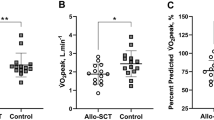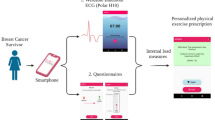Abstract
Healthy cardiac autonomic functioning (CAF) is essential for maintaining homeostasis in response to the environmental demands of everyday life. Impaired CAF is associated with higher morbidity and higher mortality. To explore CAF in survivors of allogeneic hematopoietic stem cell transplantation (allo-HSCT) 1–10 years after transplant (median=4.3 years), an ambulatory assessment was performed with 104 patients, and 45 age- and gender-matched healthy controls. Heart rate (HR) and respiratory sinus arrhythmia (RSA, that is, high-frequency HR variability) were measured in a laboratory setting and during a 12-hour naturalistic period of daily life. Cancer-related fatigue was assessed by the Functional Assessment of Chronic Illness - Fatigue questionnaire; physical fitness by bicycle-ergometry VO2max. In contrast to healthy controls, 4-year post-HSCT fatigue was greater in patients (P<0.0001, Cohen’s d effect size [d]=1.14), and fitness was lower in patients (P<0.0001, d=1.09). In both laboratory and real-life ambulatory conditions, average HR was persistently higher (P<0.0001, d=0.88) and mean RSA magnitude lower (P<0.001, d=0.69) among patients, compared with controls. Severely fatigued patients showed higher HR and lower parasympathetic cardiac control than non-fatigued patients (HR: P=0.02, d=0.47; RSA: P=0.02, d=0.72), and this was unrelated to fitness. These findings may have important implications for predicting long-term treatment outcome and consequences for routine post-HSCT care.
This is a preview of subscription content, access via your institution
Access options
Subscribe to this journal
Receive 12 print issues and online access
$259.00 per year
only $21.58 per issue
Buy this article
- Purchase on Springer Link
- Instant access to full article PDF
Prices may be subject to local taxes which are calculated during checkout



Similar content being viewed by others

References
Horan JT, Logan BR, Agovi-Johnson MA, Lazarus HM, Bacigalupo AA, Ballen KK et al. Reducing the risk for transplantation-related mortality after allogeneic hematopoietic cell transplantation: how much progress has been made? J Clin Oncol 2011; 29: 805–813.
Tichelli A, Socie G . Considerations for adult cancer survivors. Hematology Am Soc Hematol Educ Program 2005: 516–522.
Tichelli A, Bhatia S, Socie G . Cardiac and cardiovascular consequences after haematopoietic stem cell transplantation. Br J Haematol 2008; 142: 11–26.
Tichelli A, Passweg J, Wojcik D, Rovo A, Harousseau JL, Masszi T et al. Late cardiovascular events after allogeneic hematopoietic stem cell transplantation: a retrospective multicenter study of the Late Effects Working Party of the European Group for Blood and Marrow Transplantation. Haematologica 2008; 93: 1203–1210.
Fagundes CP, Murray DM, Hwang BS, Gouin JP, Thayer JF, Sollers JJ 3rd et al. Sympathetic and parasympathetic activity in cancer-related fatigue: more evidence for a physiological substrate in cancer survivors. Psychoneuroendocrinology 2011; 36: 1137–1147.
Crosswell AD, Lockwood KG, Ganz PA, Bower JE . Low heart rate variability and cancer-related fatigue in breast cancer survivors. Psychoneuroendocrinology 2014; 45: 58–66.
Giese-Davis J, Wilhelm FH, Conrad A, Abercrombie HC, Sephton S, Yutsis M et al. Depression and stress reactivity in metastatic breast cancer. Psychosom Med 2006; 68: 675–683.
Prieto JM, Atala J, Blanch J, Carreras E, Rovira M, Cirera E et al. Role of depression as a predictor of mortality among cancer patients after stem-cell transplantation. J Clin Oncol 2005; 23: 6063–6071.
Loberiza FR Jr, Rizzo JD, Bredeson CN, Antin JH, Horowitz MM, Weeks JC et al. Association of depressive syndrome and early deaths among patients after stem-cell transplantation for malignant diseases. J Clin Oncol 2002; 20: 2118–2126.
Giese-Davis J, Collie K, Rancourt KM, Neri E, Kraemer HC, Spiegel D . Decrease in depression symptoms is associated with longer survival in patients with metastatic breast cancer: a secondary analysis. J Clin Oncol 2011; 29: 413–420.
Adams MJ, Lipsitz SR, Colan SD, Tarbell NJ, Treves ST, Diller L et al. Cardiovascular status in long-term survivors of Hodgkin's disease treated with chest radiotherapy. J Clin Oncol 2004; 22: 3139–3148.
Viniegra M, Marchetti M, Losso M, Navigante A, Litovska S, Senderowicz A et al. Cardiovascular autonomic function in anthracycline-treated breast cancer patients. Cancer Chemother Pharmacol 1990; 26: 227–231.
Postma A, Bink-Boelkens MT, Beaufort-Krol GC, Kengen RA, Elzenga NJ, Schasfoort-van Leeuwen MJ et al. Late cardiotoxicity after treatment for a malignant bone tumor. Med Pediatr Oncol 1996; 26: 230–237.
Postma A, Elzenga NJ, Haaksma J, Schasfoort-Van Leeuwen MJ, Kamps WA, Bink-Boelkens MT . Cardiac status in bone tumor survivors up to nearly 19 years after treatment with doxorubicin: a longitudinal study. Med Pediatr Oncol 2002; 39: 86–92.
Brouwer CAJ, Gietema JA, van den Berg MP, Bink-Boelkens MTE, Elzenga NJ, Haaksma J et al. Long-term cardiac follow-up in survivors of a malignant bone tumour. Ann Oncol 2006; 17: 1586–1591.
Grossman P, Deuring G, Garland SN, Campbell TS, Carlson LE . Patterns of objective physical functioning and perception of mood and fatigue in posttreatment breast cancer patients and healthy controls: an ambulatory psychophysiological investigation. Psychosom Med 2008; 70: 819–828.
Walsh D, Nelson KA . Autonomic nervous system dysfunction in advanced cancer. Support Care Cancer 2002; 10: 523–528.
Martin R, Delgado JM, Molto JM, Vicent JM, Manzanares R, Insa R et al. Cardiovascular reflexes in patients with malignant disease. Ital J Neurol Sci 1992; 13: 125–129.
Bruera E, Chadwick S, Fox R, Hanson J, MacDonald N . Study of cardiovascular autonomic insufficiency in advanced cancer patients. Cancer Treat Rep 1986; 70: 1383–1387.
Fadul N, Strasser F, Palmer JL, Yusuf SW, Guo Y, Li Z et al. The association between autonomic dysfunction and survival in male patients with advanced cancer: a preliminary report. J Pain Symptom Manage 2010; 39: 283–290.
Bower JE, Bak K, Berger A, Breitbart W, Escalante CP, Ganz PA et al. Screening, assessment, and management of fatigue in adult survivors of cancer: an American Society of Clinical oncology clinical practice guideline adaptation. J Clin Oncol 2014; 32: 1840–1850.
Bower JE, Ganz PA, Desmond KA, Bernaards C, Rowland JH, Meyerowitz BE et al. Fatigue in long-term breast carcinoma survivors: a longitudinal investigation. Cancer 2006; 106: 751–758.
Lawrence DP, Kupelnick B, Miller K, Devine D, Lau J . Evidence report on the occurrence, assessment, and treatment of fatigue in cancer patients. J Natl Cancer Inst Monogr 2004; 32: 40–50.
Jager A, Sleijfer S, van der Rijt CC . The pathogenesis of cancer related fatigue: could increased activity of pro-inflammatory cytokines be the common denominator? Eur J Cancer 2008; 44: 175–181.
Ryan JL, Carroll JK, Ryan EP, Mustian KM, Fiscella K, Morrow GR . Mechanisms of cancer-related fatigue. Oncologist 2007; 12: 22–34.
Reuter K, Classen CC, Roscoe JA, Morrow GR, Kirshner JJ, Rosenbluth R et al. Association of coping style, pain, age and depression with fatigue in women with primary breast cancer. Psychooncology 2006; 15: 772–779.
Ganz PA, Bower JE . Cancer related fatigue: a focus on breast cancer and Hodgkin's disease survivors. Acta Oncol 2007; 46: 474–479.
Jones DE, Hollingsworth KG, Taylor R, Blamire AM, Newton JL . Abnormalities in pH handling by peripheral muscle and potential regulation by the autonomic nervous system in chronic fatigue syndrome. J Intern Med 2010; 267: 394–401.
Hoad A, Spickett G, Elliott J, Newton J . Postural orthostatic tachycardia syndrome is an under-recognized condition in chronic fatigue syndrome. Qjm 2008; 101: 961–965.
Newton JL, Okonkwo O, Sutcliffe K, Seth A, Shin J, Jones DE . Symptoms of autonomic dysfunction in chronic fatigue syndrome. Qjm 2007; 100: 519–526.
Grossman P, Wilhelm FH, Spoerle M . Respiratory sinus arrhythmia, cardiac vagal control, and daily activity. Am J Physiol Heart Circ Physiol 2004; 287: H728–H734.
Grossman P, van Beek J, Wientjes C . A comparison of three quantification methods for estimation of respiratory sinus arrhythmia. Psychophysiology 1990; 27: 702–714.
Buchheit M, Gindre C . Cardiac parasympathetic regulation: respective associations with cardiorespiratory fitness and training load. Am J Physiol Heart Circ Physiol 2006; 291: H451–H458.
De Meersman RE . Heart rate variability and aerobic fitness. Am Heart J 1993; 125: 726–731.
Filipovich AH, Weisdorf D, Pavletic S, Socie G, Wingard JR, Lee SJ et al. National Institutes of Health consensus development project on criteria for clinical trials in chronic graft-versus-host disease: I. Diagnosis and staging working group report. Biol Blood Marrow Transplant 2005; 11: 945–956.
Yellen SB, Cella DF, Webster K, Blendowski C, Kaplan E . Measuring fatigue and other anemia-related symptoms with the Functional Assessment of Cancer Therapy (FACT) measurement system. J Pain Symptom Manage 1997; 13: 63–74.
Astrand PO, Ryhming I . A nomogram for calculation of aerobic capacity (physical fitness) from pulse rate during sub-maximal work. J Appl Physiol 1954; 7: 218–221.
Thorsen L, Skovlund E, Stromme SB, Hornslien K, Dahl AA, Fossa SD . Effectiveness of physical activity on cardiorespiratory fitness and health-related quality of life in young and middle-aged cancer patients shortly after chemotherapy. J Clin Oncol 2005; 23: 2378–2388.
Grossman P . The LifeShirt: a multi-function ambulatory system monitoring health, disease, and medical intervention in the real world. Stud Health Technol Inform 2004; 108: 133–141.
Wilhelm FH, Roth WT, Sackner MA . The lifeShirt. An advanced system for ambulatory measurement of respiratory and cardiac function. Behav Modif 2003; 27: 671–691.
Walters JA, Wood-Baker R, Walls J, Johns DP . Stability of the EasyOne ultrasonic spirometer for use in general practice. Respirology 2006; 11: 306–310.
Skloot GS, Edwards NT, Enright PL . Four-year calibration stability of the EasyOne portable spirometer. Respir Care 2010; 55: 873–877.
Grossman P, Karemaker J, Wieling W . Prediction of tonic parasympathetic cardiac control using respiratory sinus arrhythmia: the need for respiratory control. Psychophysiology 1991; 28: 201–216.
Grossman P, Kollai M . Respiratory sinus arrhythmia, cardiac vagal tone, and respiration: within- and between-individual relations. Psychophysiology 1993; 30: 486–495.
Mann HB, Whitney DR . On a test of whether one of two random variables is stochastically larger than the other. Ann Math Stat 1947; 18: 50–60.
Schiff D, Wen PY, van den Bent MJ . Neurological adverse effects caused by cytotoxic and targeted therapies. Nat Rev Clin Oncol 2009; 6: 596–603.
Verstappen CC, Heimans JJ, Hoekman K, Postma TJ . Neurotoxic complications of chemotherapy in patients with cancer: clinical signs and optimal management. Drugs 2003; 63: 1549–1563.
Sioka C, Kyritsis AP . Central and peripheral nervous system toxicity of common chemotherapeutic agents. Cancer Chemother Pharmacol 2009; 63: 761–767.
Acknowledgements
We thank the Swiss Cancer League for funding this study (grant no.: KLS-02038-02-2007). Special thanks to the nurses and physicians of the Zellersatzambulatorium of the Hematology Department of University Hospital Basel for great collaboration and logistical support. Above all, we thank all study participants.
Author information
Authors and Affiliations
Corresponding authors
Ethics declarations
Competing interests
The authors declare no conflict of interest.
Additional information
Supplementary Information accompanies this paper on Bone Marrow Transplantation website
Supplementary information
Rights and permissions
About this article
Cite this article
Deuring, G., Kiss, A., Halter, J. et al. Cardiac autonomic functioning is impaired among allogeneic hematopoietic stem cell transplantation survivors: a controlled study. Bone Marrow Transplant 52, 66–72 (2017). https://doi.org/10.1038/bmt.2016.176
Received:
Revised:
Accepted:
Published:
Issue Date:
DOI: https://doi.org/10.1038/bmt.2016.176
This article is cited by
-
Orthostatic intolerance syndromes after hematopoietic cell transplantation: clinical characteristics and therapeutic interventions in a single-center experience
Cardio-Oncology (2021)
-
Quantitative assessment of cardiovascular autonomic impairment in cancer survivors: a single center case series
Cardio-Oncology (2020)


